The Performance of a Spectral Wave Model at Predicting Wave Farm Impacts
Abstract
1. Introduction
- Medium-sized arrays of 27 WECs are modeled, representing a medium-sized wave farm. Smaller arrays of 5 WECs were compared in McNatt et al. [20], and, while larger arrays could be considered in the future, an array of 27 WECs represents a medium-sized wave farm and is a stepping stone in both the development of commercial wave farms and the verification of SNL-SWAN. To model these arrays, an approach referred to as Linear Wave Interaction Theory (LWIT) was used.
- Only directionally spread sea conditions are modeled, based on literature on the range of realistic directional spreading [21]. The range of directional spreading includes highly focused storm waves, however it does not include idealized purely unidirectional seas. In previous studies, SNL-SWAN did not show good agreement with linear wave theory for unidirectional seas because without the SWAN diffraction option on, it is not capably of wave diffraction [19]. However, directional spreading is a form of wave diffraction and unidirectional seas are not representative of real sea conditions.
- A realistic beach bathymetry is used. In previous studies, the authors considered only a flat sea bottom. However, the aim of SNL-SWAN is to assess the impact of wave farms on nearshore processes. As such, the wave fields produced by each method were fed in as boundary conditions for a SWAN model that propagates the wave field to shore.
2. Methods
2.1. Computational Methods
2.1.1. SNL-SWAN
2.1.2. Linear Wave Interaction Theory
2.2. WEC Arrays
2.3. Environment
2.4. Computational Domains
- Array Domain: the domain around the WEC array located offshore. This domain is evaluated either with SNL-SWAN or with LWIT. The bathymetry is a flat bottom.
- Nearshore Domain: the domain with a beach-profile bottom extending to a depth of 0 at the shoreline. It is modeled always with SWAN.
2.5. Means of Comparison
2.5.1. Normalized
2.5.2. Normalized Error
Mean-Squared Error
2.5.3. Mean-Squared Skill Score
- would be produced by not modeling the WEC array at all.
- : SNL-SWAN produces worse results compared to not modeling the WEC array at all.
- : SNL-SWAN exactly matches LWIT results (no error).
- : SNL-SWAN makes some improvement to the wave field (compared to not modeling the array at all).
3. Results
3.1. Example Results
3.2. General Considerations
3.2.1. Wave Breaking
3.2.2. Boundary Condition Effects
3.2.3. Garden Sprinkler Effect
3.3. Mean-Squared Skill Score Results
3.4. Visualization of Results
- How significant are the impacts of the array?
- Are the errors between SNL-SWAN and LWIT meaningful in the context of nearshore physical processes?
4. Conclusions
Author Contributions
Funding
Acknowledgments
Conflicts of Interest
Abbreviations
| BC | Boundary condition |
| BEM | Boundary-element method |
| Significant wave height | |
| LWIT | Linear wave interaction theory |
| MSE | Mean-squared error |
| MSSS | Mean-squared skill score |
| RCW | Relative capture width |
| SNL | Sandia National Laboratories |
| SWAN | Simulating WAves Nearshore |
| Peak wave period | |
| WEC | Wave energy converter |
References
- Gunn, K.; Stock-Williams, C. Quantifying the global wave power resource. Renew. Energy 2012, 44, 296–304. [Google Scholar] [CrossRef]
- The SWAN Team. SWAN Scientific and Technical Documentation; Delft University of Technology: Delft, The Netherlands, 2020. [Google Scholar]
- Millar, D.; Smith, H.; Reeve, D. Modelling analysis of the sensitivity of shoreline change to a wave farm. Ocean Eng. 2007, 34, 884–901. [Google Scholar] [CrossRef]
- de Leon, S.P.; Bettencourt, J.H.; Kjerstad, N. Simulation of irregular waves in an offshore wind farm with a spectral wave model. Cont. Shelf Res. 2011, 31, 1541–1557. [Google Scholar] [CrossRef]
- Smith, H.; Pearce, C.; Millar, D. Further analysis of change in nearshore wave climate due to an offshore wave farm: An enhanced case study for the Wave Hub site. Renew. Energy 2011, 40, 51–64. [Google Scholar] [CrossRef]
- Iglesias, G.; Veigas, M. Wave farm impact and wave-WEC interaction: A sensitivity analysis. In Proceedings of the 10th European Wave and Tidal Energy Conference, Aalborg, Denmark, 2–5 September 2013. [Google Scholar]
- Carballo, R.; Iglesias, G. Wave farm impact based on realistic wave-WEC interaction. Energy 2013, 51, 216–229. [Google Scholar] [CrossRef]
- Abanades, J.; Greaves, D.; Iglesias, G. Wave farm impact on the beach profile: A case study. Coast. Eng. 2014, 86, 36–44. [Google Scholar] [CrossRef]
- Rusu, E.; Onea, F. Study on the influence of the distance to shore for a wave energy farm operating in the central part of the Portuguese nearshore. Energy Convers. Manag. 2016, 114, 209–223. [Google Scholar] [CrossRef]
- Astariz, S.; Iglesias, G. Co-located wind and wave energy farms: Uniformly distributed arrays. Energy 2016, 113, 497–508. [Google Scholar] [CrossRef]
- Ruehl, K.; Chartrand, C.; Porter, A. SNL-SWAN User’s Manual; Sandia National Laboratories: Albuquerque, NM, Bernalillo, 2014. [Google Scholar]
- Chang, G.; Ruehl, K.; Jones, C.; Roberts, J.; Chartrand, C. Numerical modeling of the effects of wave energy converter characteristics on nearshore wave conditions. Renew. Energy 2016, 89, 636–648. [Google Scholar] [CrossRef]
- Luczko, A.; Robertson, B.; Bailey, H.; Hiles, C.; Buckham, B. Representing non-linear wave energy converters in coastal wave models. Renew. Energy 2018, 118, 376–385. [Google Scholar] [CrossRef]
- Stratigaki, V.; Troch, P.; Forehand, D. A fundamental coupling methodology for modeling near-field and far-field wave effects of floating structures and wave energy devices. Renew. Energy 2019, 143, 1608–1627. [Google Scholar] [CrossRef]
- Özkan-Haller, H.T.; Haller, M.C.; McNatt, J.C.; Porter, A.; Lenee-Bluhm, P. Analyses of Wave Scattering and Absorption Produced by WEC Arrays: Physical/Numerical Experiments and Model Assessment. In Marine Renewable Energy: Resource Characterization and Physical Effects; Springer: Berlin/Heidelbreg, Germany, 2017; pp. 279–304. [Google Scholar]
- WAMIT, Inc. WAMIT User Manual—Ver 7.3; WAMIT Inc.: Chestnut Hill, MA, USA, 2019. [Google Scholar]
- Greenwood, C.; Christie, D.; Venugopal, V.; Morrison, J.; Vogler, A. Modelling performance of a small array of Wave Energy Converters: Comparison of Spectral and Boussinesq models. Energy 2016, 113, 258–266. [Google Scholar] [CrossRef]
- Venugopal, V.; Nemalidinne, R.; Vögler, A. Numerical modelling of wave energy resources and assessment of wave energy extraction by large scale wave farms. Ocean Coast. Manag. 2017, 147, 37–48. [Google Scholar] [CrossRef]
- McNatt, J.; Porter, A.; Ruehl, K.; Roberts, J. Verification of the SNL-SWAN Spectral WEC-wave Model with Phase-resolved Linear Wave Fields. In Proceedings of the 12th European Wave and Tidal Energy Conference, Cork, Ireland, 27 August–1 September 2017. [Google Scholar]
- McNatt, J.; Porter, A.; Ruehl, K. Comparison of Numerical Methods for Modeling the Wave Field Effects Generated by Individual Wave Energy Converters and Multiple Converter Wave Farms. J. Mar. Sci. Eng. 2020, 8, 168. [Google Scholar] [CrossRef]
- Forristall, G.Z.; Ewans, K.C. Worldwide measurements of directional wave spreading. J. Atmos. Ocean. Technol. 1998, 15, 440–469. [Google Scholar] [CrossRef]
- Folley, M. Numerical Modelling of Wave Energy Converters: State-of-the-Art Techniques for Single Devices and Arrays; Elsevier: Amsterdam, The Netherlands, 2016. [Google Scholar]
- McNatt, J.; Venugopal, V.; Forehand, D.; Payne, G. Experimental Analysis of Cylindrical Wave Fields. In Proceedings of the 11th European Wave and Tidal Energy Conference, Nantes, France, 6–11 September 2015. [Google Scholar]
- McNatt, J.; Venugopal, V.; Forehand, D. A novel method for deriving the diffraction transfer matrix and its application to multi-body interactions in water waves. Ocean Eng. 2015, 94, 173–185. [Google Scholar] [CrossRef]
- Kagemoto, H.; Yue, D.K.P. Interactions among multiple three-dimensional bodies in water waves: An exact algebraic method. J. Fluid Mech. 1986, 166, 189–209. [Google Scholar] [CrossRef]
- Child, B.; Venugopal, V. Optimal configurations of wave energy device arrays. Ocean Eng. 2010, 37, 1402–1417. [Google Scholar] [CrossRef]
- Goo, J.S.; Yoshida, K. A numerical method for huge semisubmersible response in waves. Trans. Soc. Nav. Archit. Mar. Eng. 1990, 98, 365–387. [Google Scholar]
- McNatt, J.C. Cylindrical Linear Water Waves and Their Application to the Wave Body Problem. Ph.D. Thesis, The University of Edinburgh, Edinburgh, UK, 2016. [Google Scholar]
- Bruun, P. Coastal Erosion and the Development of Beach Profiles; Technical Report Technical Memorandum 44; Army Corps of Engineers: Washington, DC, USA, 1954. [Google Scholar]
- Dallman, A.; Neary, V. Characterization of U.S. Wave Energy Converter (wec) Test Sites: A Catalogue of Met-Ocean Data; Technical Report SAND2014-18206; Sandia National Laboratories: Albuquerque, NM, USA, 2014. [Google Scholar]
- Mitsuyasu, H.F.; Tasai, F.; Suhara, T.; Mizuno, S.; Ohkuso, M.; Honda, T.; Rikiishi, K. Observations of the directional spectrum of ocean waves using a cloverleaf buoy. J. Phys. Oceanogr. 1975, 5, 750–760. [Google Scholar] [CrossRef]
- Sutherland, J.; Peet, A.H.; Soulsby, R.L. Evaluating the performance of morphological models. Coast. Eng. 2004, 51, 917–939. [Google Scholar] [CrossRef]
- Inghilesi, R.; Catini, F. and Bellotti, G.; Franco, L.; Orasi, A.; Corsini, S. Implementation and validation of a coastal forecasting system for wind waves in the Mediterranean Sea. Nat. Hazards Earth Syst. Sci. 2012, 12, 485–495. [Google Scholar] [CrossRef]
- Allard, R.; Rogers, W.E.; Carroll, S.N.; Rushing, K.V. Validation Test Report for the Simulation Waves Nearshore Model (SWAN) Cycle III, Version 40.11; Technical Report NRL/FR/7322–04-10,070; Naval Research Labboratory: Washington, DC, USA, 2004. [Google Scholar]

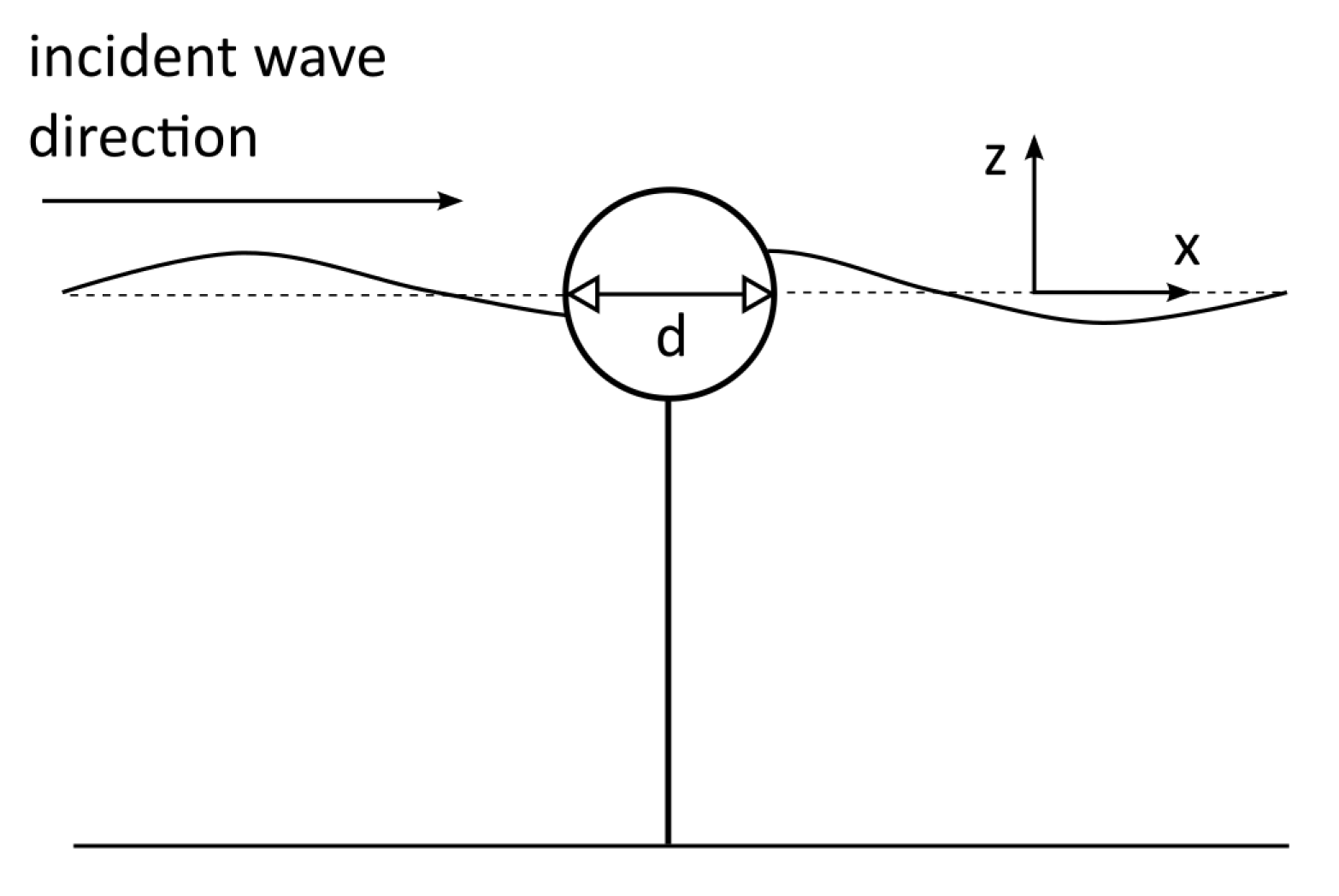


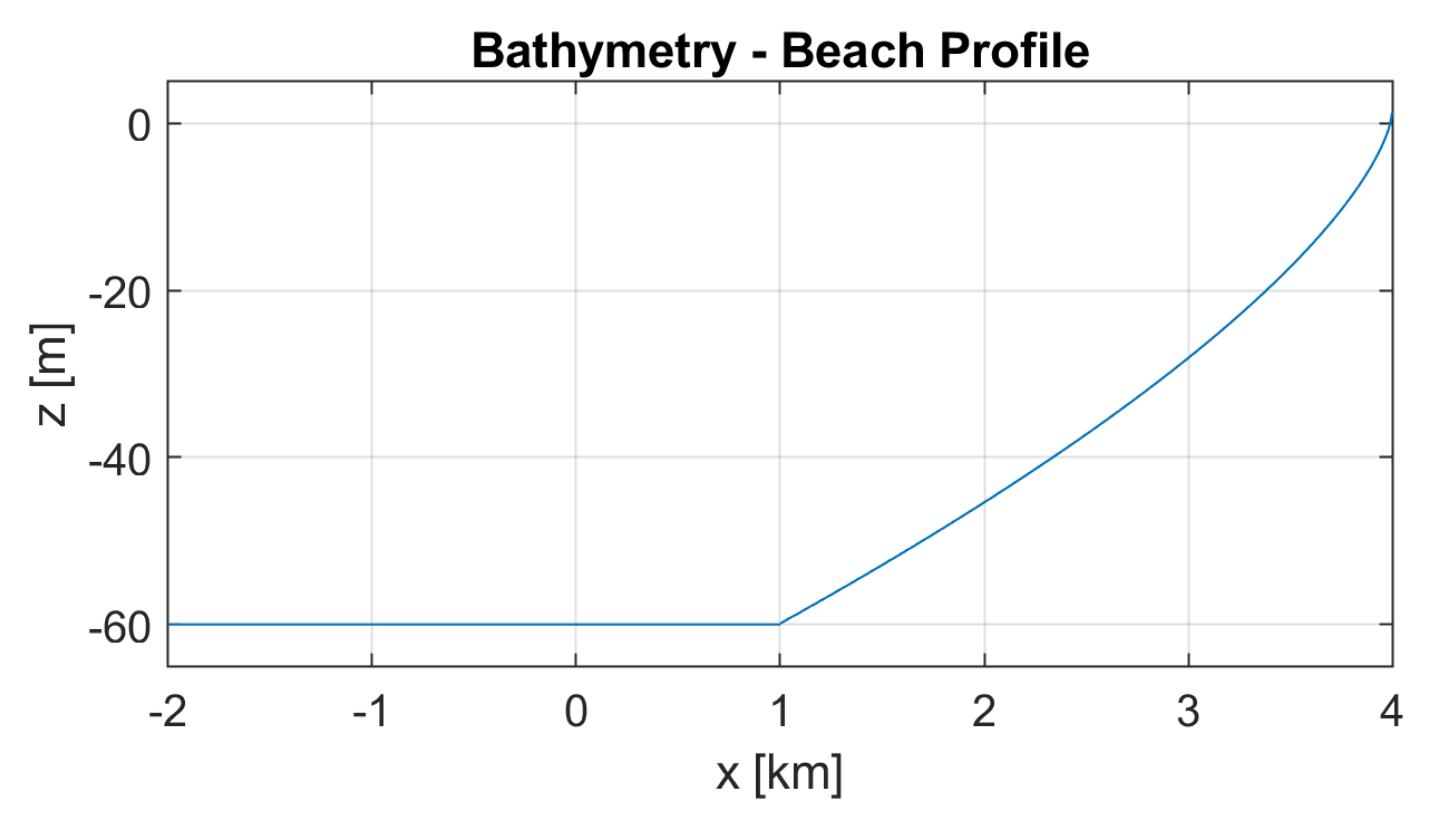
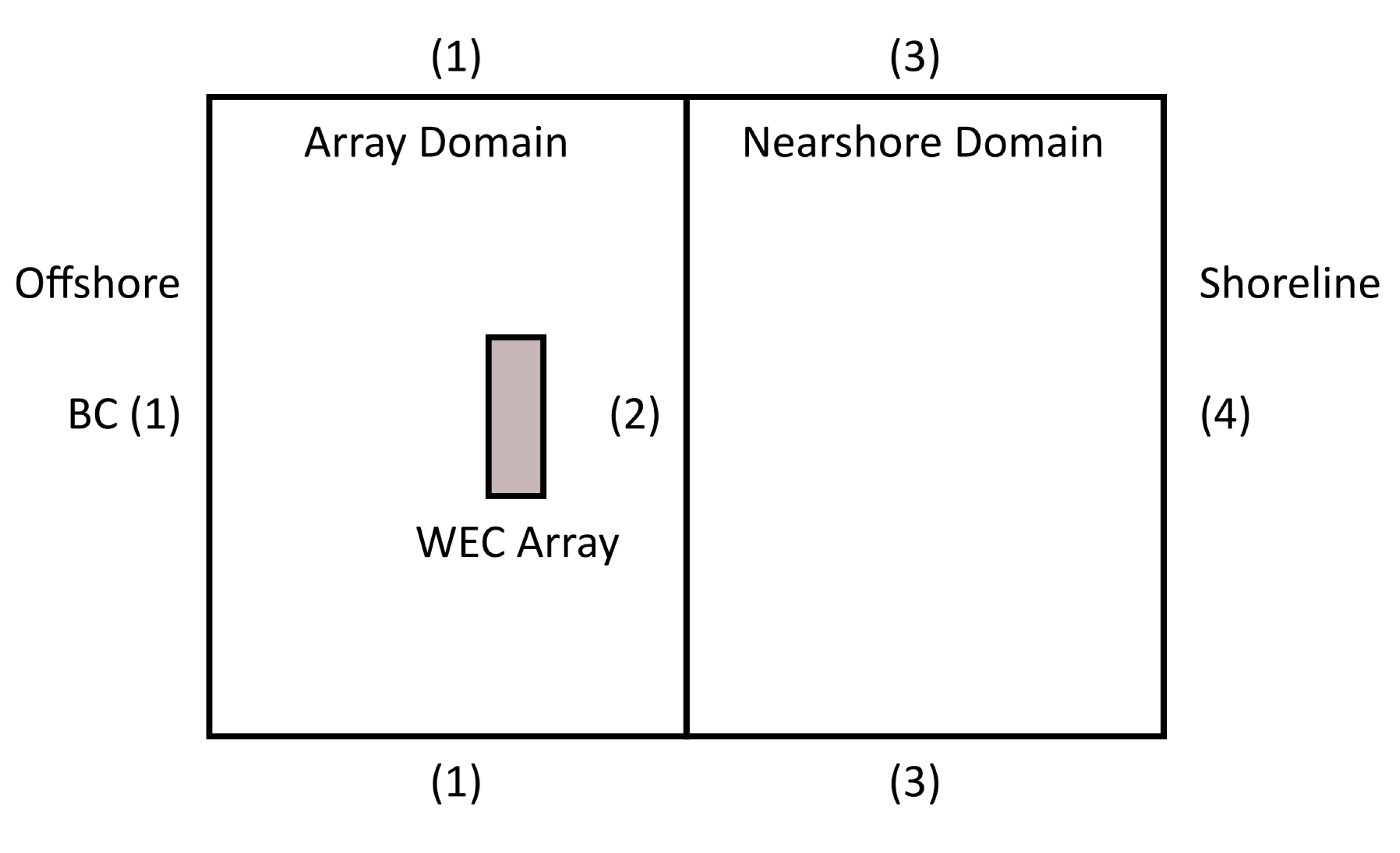
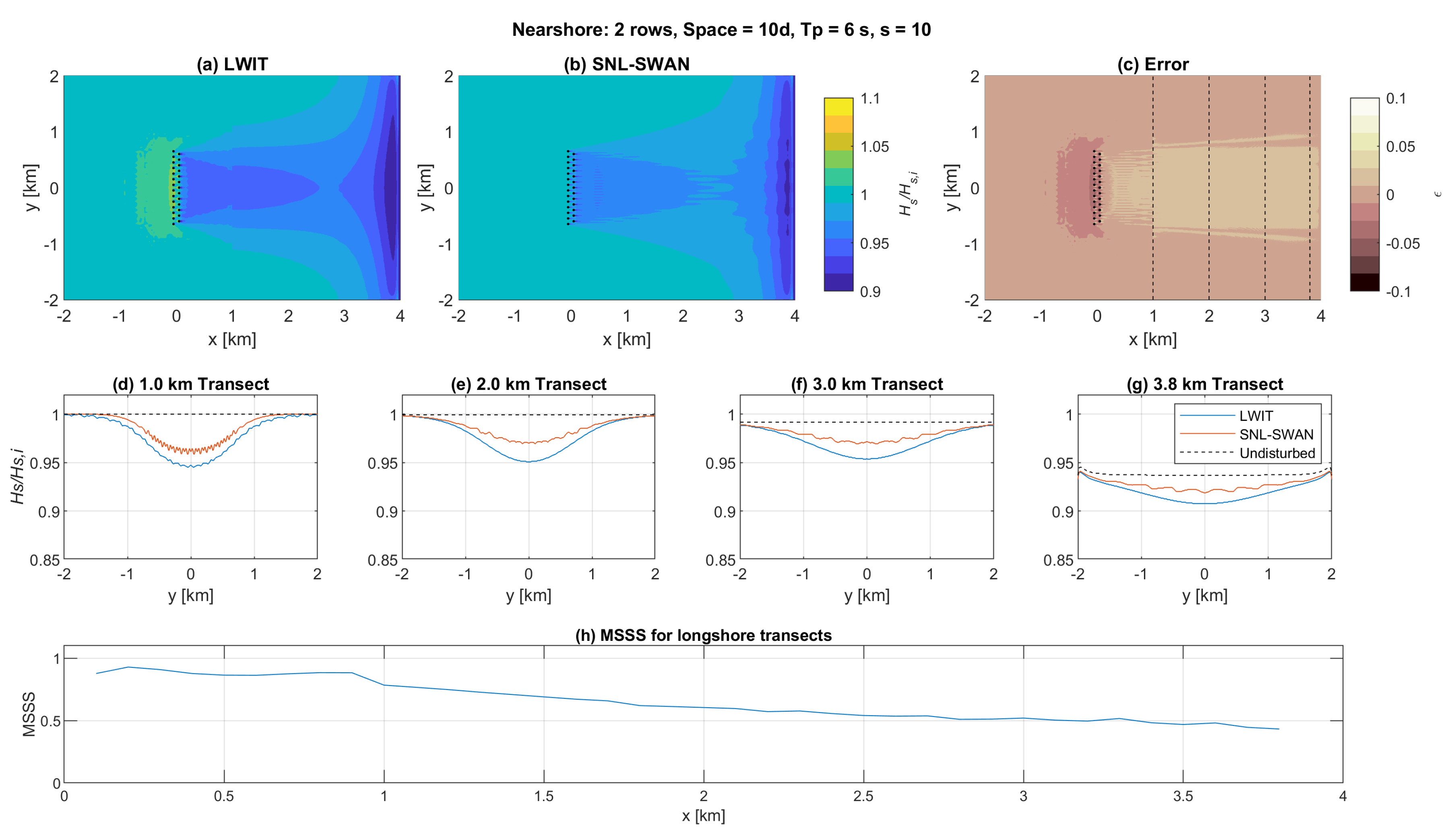

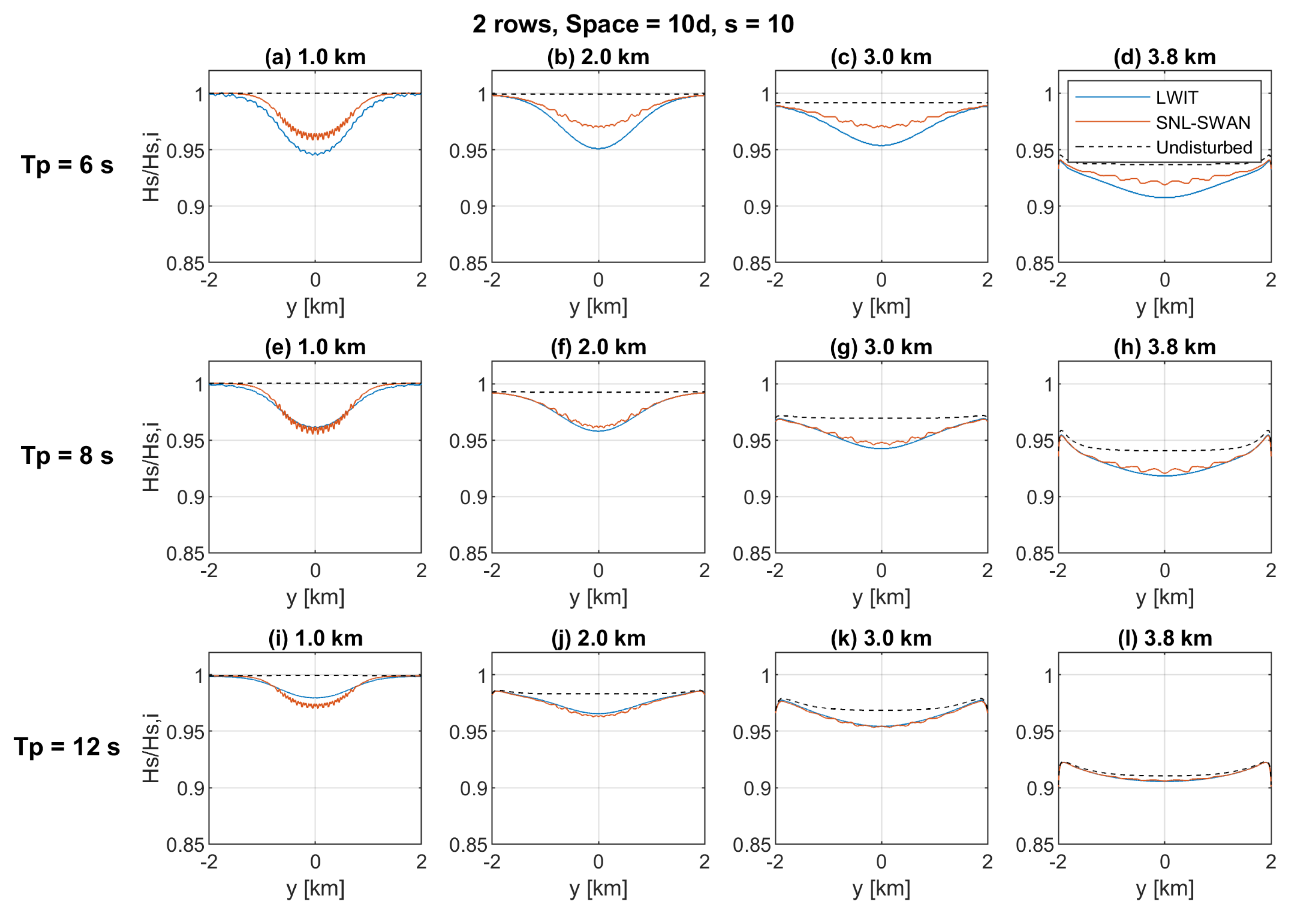


| MSSS | Performance |
|---|---|
| 0.5–1 | Excellent |
| 0.2–0.5 | Good |
| 0.1–0.2 | Fair |
| 0–0.1 | Poor |
| <0 | Bad |
| Tp | Excellent | Good |
|---|---|---|
| () | () | |
| 6s | 5 | 7 |
| 8s | 12 | 0 |
| 12s | 12 | 0 |
| [m] | [m] | |
|---|---|---|
| 6s | 0.089 | 0.041 |
| 8s | 0.098 | 0.042 |
| 12s | 0.207 | 0.097 |
Publisher’s Note: MDPI stays neutral with regard to jurisdictional claims in published maps and institutional affiliations. |
© 2020 by the authors. Licensee MDPI, Basel, Switzerland. This article is an open access article distributed under the terms and conditions of the Creative Commons Attribution (CC BY) license (http://creativecommons.org/licenses/by/4.0/).
Share and Cite
McNatt, J.C.; Porter, A.; Chartrand, C.; Roberts, J. The Performance of a Spectral Wave Model at Predicting Wave Farm Impacts. Energies 2020, 13, 5728. https://doi.org/10.3390/en13215728
McNatt JC, Porter A, Chartrand C, Roberts J. The Performance of a Spectral Wave Model at Predicting Wave Farm Impacts. Energies. 2020; 13(21):5728. https://doi.org/10.3390/en13215728
Chicago/Turabian StyleMcNatt, J. Cameron, Aaron Porter, Christopher Chartrand, and Jesse Roberts. 2020. "The Performance of a Spectral Wave Model at Predicting Wave Farm Impacts" Energies 13, no. 21: 5728. https://doi.org/10.3390/en13215728
APA StyleMcNatt, J. C., Porter, A., Chartrand, C., & Roberts, J. (2020). The Performance of a Spectral Wave Model at Predicting Wave Farm Impacts. Energies, 13(21), 5728. https://doi.org/10.3390/en13215728





